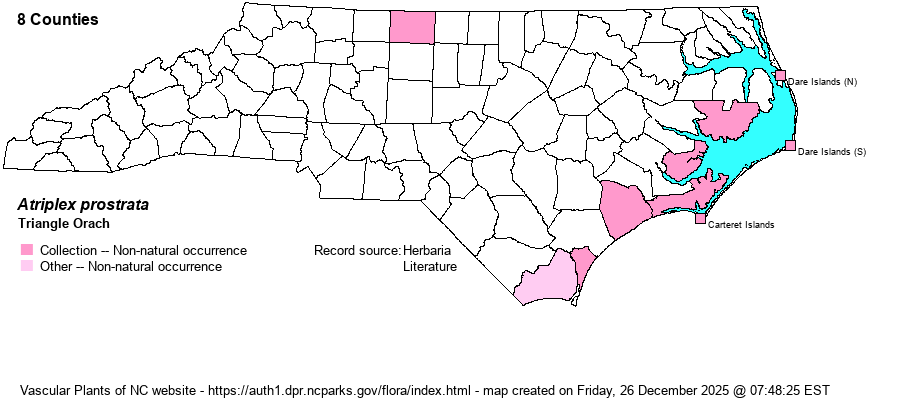| Author | Boucher ex A.P. de Candolle | |
| Distribution | Coastal; believed to be not native in the eastern U.S., and possibly not even native at all in North America. Definitely Eurasian in native origin. The Rockingham County collection is from a railroad track in Reidsville. Weakley (2024) treats the species as non-native in the Southeastern states. Named as Atriplex patula in RAB (1968).
Native to Eurasia; in N.A. east and west coasts and inland in saline soils. | |
| Abundance | Uncommon on the outer Coastal Plain and Outer Banks; disjunct and rare inland. The State Rank is SE? -- Probably exotic. | |
| Habitat | Tidal marshes and marsh edges; brackish flats. | |
| Phenology | Flowering and fruiting July-November. | |
| Identification | Both this species and A. dioica have broadly to narrowly triangular leaves, usually with 2 basal pointy lobes. According to FNA, leaves of dioica are more likely to be narrow, thick-textured, and surfaces scurfy, whereas prostrata leaves are broad, thin-textured, and not scurfy. | |
| Taxonomic Comments | Weakley (2018) recognized A. patula sensu stricto as distinct from A. prostrata, but in 2020, he moved it into that species.
Members of the genus are most often found in saline to brackish sands. Male flowers usually produce petals, but females do not; in any event they are very small and not at all showy. Weakley's (2018) key must be used with care, and a dissecting scope is almost essential for successful identification. | |
| Other Common Name(s) | | |
| State Rank | SE? * | |
| Global Rank | G5 | |
| State Status | | |
| US Status | | |
| USACE-agcp | FACW link |
| USACE-emp | FACW link |

